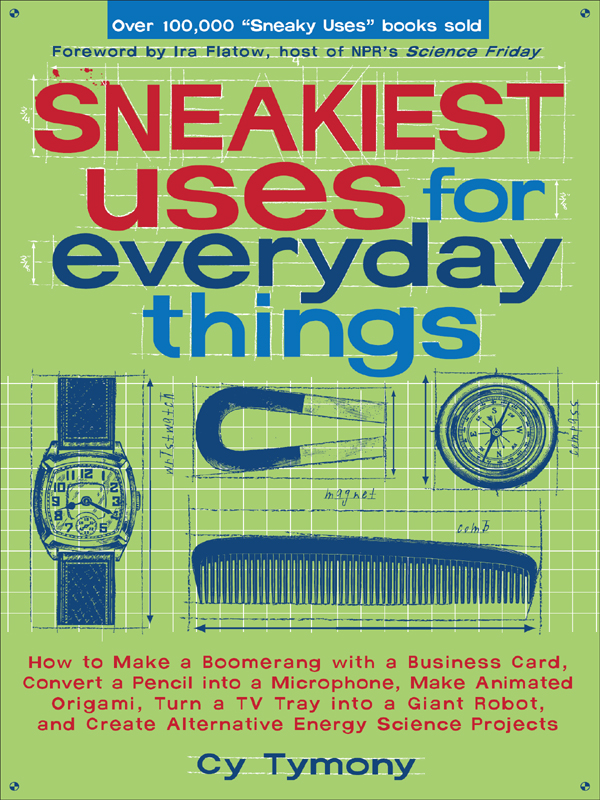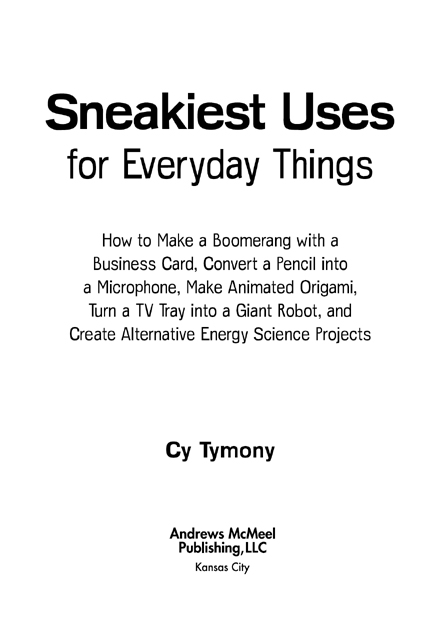This book is for the entertainment and edification of its readers. While reasonable care has been exercised with respect to its accuracy, the publisher and the author assume no responsibility for errors or omissions in its content. Nor do we assume liability for any damages resulting from use of the information presented here. This book contains references to electrical safety that
be observed.
Do not place or store magnets near such magnetically sensitive media as videotapes, audiotapes, or computer disks. Disparities in materials and design methods and the application of the components may cause your results to vary from those shown here.
The publisher and the author disclaim any liability for injury that may result from the use, proper or improper, of the information contained in this book. We do not guarantee that the information contained herein is complete, safe, or accurate, nor should it be considered a substitute for your good judgment and common sense. Nothing in this book should be construed or interpreted to infringe on the rights of other persons or to violate criminal statutes. We urge you to obey all laws and respect all rights, including property rights, of others.
Contents
PART I Sneaky Science Tricks
PART II Sneaky Gadgets
PART III Sneaky Energy Projects and Simulations
Part IV Bonus Sections
Foreword by Ira Flatow
I was one of those kids who loved to tear things apart and put them back together. Old black-and-white TVs, washing machine motors, and solenoids littered my basement.
Countless hours would be spent dissecting and building electronic gadgets in the coolness of that dark refuge. I was what we would call today a geek. I even wore a pocket protector (and when I studied engineering in college, I collected four slide rules). Those postwar days, in the late 1950s and 60s, were ripe for we subterranean gadgeteers. Lower Manhattan was filled with surplus electronic parts and WWII junk just waiting for vultures like myself to descend and buy them by the pound or part. Decades before the World Trade Center was ever built, the streets that define that neighborhood were cluttered with cardboard boxes and tables overflowing with resistors, vacuum tubes, circuit boards, and knobs of every kind.
Radios and TVs spilled into the streets, and lucky was the kid who could afford to bring home the innards of a real, live radarscope. Who knows what ship it had served, what foreign planes had blipped across its screen? These were our fields of dreams, where hobbyists could find all the ingredients they needed for homebrew creations. It was a paradise. And then I grew up. I left home, abandoning my Heathkits and Popular Electronics projects (I made a four-transistor radio!). My science fair punch-card reader collected dust, my oscilloscope never to be turned on again.
Those days of wonderful creativity slowly faded away, becoming cherished memories of youth. Modern computer chips made once-simple soldering techniques more risky and unnecessary. Heathkit went out of business. Radio Shack cut way back on its hobbyist section. The Internet captured most of my attention. My tinkering juices were never to be stirred up again, I thought.
Then I discovered Cy Tymony. His books drew me like a moth to a flame. There, amid the pages of hand-drawn illustrations, were the kinds of projects I hadnt seen in years. Decades. Half a lifetime. With a few twists of a screwdriver, you could turn an ordinary radio into a magical box where airline pilots talk to one other.
You could make all kinds of stuff out of parts just lying around the house. I could tinker again! Thank you, Cy, for reinvigorating those creative juices. We all owe you a debt of gratitude for reinventing the old days for we veterans of the vacuum tube era. And for opening up the world of tinkering and creativity to a whole new generation of hobbyists looking to get their hands dirty with new and exciting projects.
Ira Flatow Science Friday
Acknowledgments
Special thanks to my agents, Sheree Bykofsky and Janet Rosen, for believing in the book series from the start. I want to also thank Katie Anderson, my editor at Andrews McMeel, for her invaluable insights. Im also grateful to the following people who helped spread the word about the first two Sneaky Uses books: Gayle Anderson, Ira Flatow, Susan Casey, Sandy Cohen, Katey Schwartz, Cherie Courtage, Mike Suan, John Schatzel, Mark Frauenfelder, Melissa Gwynne, Steve Cochran, Christopher G.
Selfridge, Timothy M. Blangger, Charles Bergquist, Phillip M. Torrone, M. K. Donaldson, Paul MacGregor, David Chang, Jessica Warren, Steve Metsch, Jenifer N. Johnson, Jerry Davich, Jerry Reno, Austin Michael, Tony Lossano, Diane Lewis, Bob Kostanczuk, Marty Griffin, Mackenzie Miller, Rebecca Schuler, Larry Elder, Dennis Prager, Carlos Daza, Paul Scott, Ronald Mitchell, and Bruce Pasarow.
Im thankful for the project evaluation and testing assistance provided by Bill Melzer, Sybil Smith, Isaac English, and Jerry Anderson. And a special thanks to Clyde Tymony, Helen Cooper, and my mother, Cloise Shaw, for giving me positive inspiration, a foundation in science, and a love of reading.
Introduction
Life is what you make it.
People rarely think about the common items and devices they use in everyday life. They think even less about adapting them to perform other functions. You can easily learn how to become a real-life MacGyver using nothing but everyday items at your disposal. It doesnt hurt to have the smarts of Einstein or the strength of Superman, but theyre not necessary with
Sneakiest Uses for Everyday Things. When life puts you in a bind, the best solution is frequently not the obvious one.
Itll be the sneaky one. Solutions to a dilemma can come from the most unlikely sources:
- U.S. prisoners of war devised stealthy makeshift radio receivers using nothing more than a razor blade, a pencil, and wire from the wire fence from the prison camp as an antenna.
- Convicts at correctional institutions have used dental floss to saw through cell bars, and floss to braid a 20-foot rope to scale a wall. An inventive inmate escaped by using a Monopoly game piece, the wheelbarrow, to unscrew his ceiling vent.
- Prisoners of war at Germanys Colditz Castle prison during World War II used cotton sleeping bags, nails, and wood from floorboards in their cells to construct a two-man, 19-foot glider with a 33-foot wingspan.
- Prisoners of war at Germanys Colditz Castle prison during World War II used cotton sleeping bags, nails, and wood from floorboards in their cells to construct a two-man, 19-foot glider with a 33-foot wingspan.
The resourceful prisoners made drills from the nails, saw handles from bed boards, and saw blades from a wind-up record players spring and from the frame around iron window bars. To cover the gliders wooden frame, they used bedsheets that they painted with hot millet (part of their rations) to stiffen the fabric. The flight never took place because the prisoners were rescued by the Americans in 1945. (Pictures and more details about the Colditz glider can be seen at www.sneakyuses.com.)






